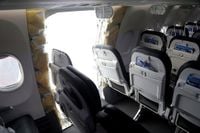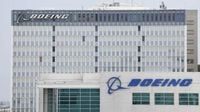The Federal Aviation Administration (FAA) has thrown the spotlight back on Boeing, proposing a $3.1 million fine against the aerospace giant for a string of safety and quality control violations that occurred between September 2023 and February 2024. This move, announced on September 13, 2025, comes in the wake of a dramatic incident earlier in the year—a door plug blowing out mid-flight on an Alaska Airlines Boeing 737 Max 9, sparking renewed scrutiny of Boeing's manufacturing and oversight practices.
The January 5, 2024, Alaska Airlines flight from Portland, Oregon, was carrying 171 passengers and six crew when, just six minutes after takeoff, a 2-by-4 foot door plug panel detached from the fuselage in the 26th row. In a harrowing moment, seat parts, electronic devices, and even the shirt off a 15-year-old passenger were sucked out of the aircraft. Miraculously, the pilots managed to land the plane safely back in Portland, and no one was seriously injured, according to NPR and The Seattle Times.
This near-disaster, while not resulting in fatalities, reignited concerns about the Boeing 737 Max line—a model already infamous following two fatal crashes in 2018 and 2019 that claimed 346 lives. Those tragedies had previously led to a worldwide grounding of the Max and a reckoning for Boeing and its regulators. As Gizmodo and Azernews reported, the FAA’s newly proposed fine now represents its “maximum statutory civil penalty authority consistent with law,” though many critics view the amount as paltry compared to Boeing’s vast revenues.
According to the FAA, the violations that prompted this fine were not isolated. Investigators identified hundreds of quality system violations at Boeing’s 737 factory in Renton, Washington, and at Spirit AeroSystems’ facility in Wichita, Kansas, which supplies fuselages for the Max line. The FAA’s findings revealed a troubling pattern: Boeing presented two unairworthy aircraft for airworthiness certification and failed to adhere to its own quality system protocols. The agency also cited interference with the independence of safety officials, a particularly alarming revelation given the company’s recent history.
One of the most damning details involved a Boeing employee pressuring a member of the FAA’s Organization Designation Authorization (ODA) program—a system that allows certain Boeing employees to perform inspections and certifications on the FAA’s behalf. According to the FAA, this employee was urged to sign off on a 737 Max aircraft that did not meet regulatory standards, simply to keep up with delivery schedules. Such pressure on ODA workers has been a recurring concern, with some employees reportedly fearing retaliation if they raise safety issues, as highlighted by The Seattle Times.
In response to the FAA’s announcement, Boeing issued a statement expressing regret over the January 2024 door-plug accident and outlining steps taken to address the underlying issues. “We regret the January 2024 door-plug accident and continue to work on strengthening our safety culture and improving first-time quality and accountability across our operations,” a Boeing spokesperson said, as quoted by NPR and Gizmodo. The company emphasized the implementation of a Safety & Quality Plan under FAA oversight, which includes key performance indicators, increased workforce training, strengthened compliance, and encouragement for employees to speak up about potential problems.
Despite these assurances, industry analysts remain skeptical. William Alderman, founding partner of aerospace financial firm Alderman and Co., characterized the fine as a “gentle slap on the wrist,” noting that it would not materially impact Boeing’s earnings or free cash flow. With $22.8 billion in revenue reported for the most recent fiscal quarter and a net loss of $612 million from April through June 2025, the $3.1 million penalty pales in comparison. Previous fines have been larger: the FAA issued a $17 million penalty in 2021 for 737 production mistakes and $12 million in 2015 for falsified paperwork, as reported by The Seattle Times.
Other observers, like Scott Hamilton of Leeham News, interpret the FAA’s action as evidence that Boeing’s much-touted reforms following the 2018 and 2019 crashes may have been more “smoke and mirrors than substance.” He pointed to the recurrence of ODA-related pressure and quality lapses as signs that deep-rooted cultural issues persist within the company.
The FAA’s own role has not escaped criticism. The National Transportation Safety Board’s 17-month investigation into the January door plug blowout concluded that both Boeing’s manufacturing lapses and ineffective FAA inspections contributed to the incident. This has fueled ongoing debate about whether the FAA is sufficiently independent from the companies it regulates—a concern that has dogged the agency since the original 737 Max tragedies.
In the aftermath of the Alaska Airlines blowout, the FAA imposed a cap on Boeing’s production rates and increased the number of inspectors at its factories in an effort to restore order and confidence in the manufacturing process. Boeing has 30 days to respond to the FAA’s letter detailing the proposed fines; the full contents of the letter have not been made public, and the FAA declined to provide further details when contacted by Gizmodo.
Boeing’s response to this crisis includes not only internal reforms but also structural changes. The company has announced plans to reacquire Spirit AeroSystems, bringing the supplier back in-house roughly two decades after it was spun off. This move, pending regulatory approval, is expected to finalize later in 2025 and is seen as a step toward tightening oversight and quality control throughout the supply chain.
Meanwhile, Boeing’s troubles are not limited to the 737 Max. In June 2025, a Boeing 787 operated by Air India crashed shortly after takeoff, resulting in at least 270 deaths. Investigators have not yet determined the cause, but so far, no flaws have been found with the 787 model, which has generally maintained a strong safety record.
As Boeing works to restore its reputation and stabilize production, CEO Kelly Ortberg—who took the helm after the ouster of Dave Calhoun following the January blowout—has stated that the company is focused on improving factory quality and gradually increasing output. The current production rate stands at 38 planes per month, with a target of reaching 42 by year’s end.
For now, the FAA’s $3.1 million fine serves as a pointed reminder that regulators are watching closely, and that the journey to regaining public trust in Boeing’s airplanes is far from over. Whether these latest measures will finally turn the tide remains to be seen, but for passengers, regulators, and industry insiders alike, the stakes could not be higher.



